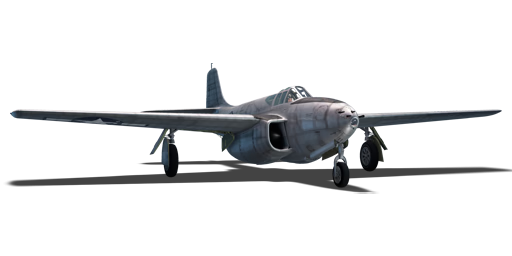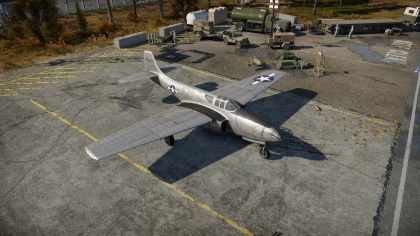P-59A
Contents
Description
The P-59A is a gift rank IV American jet fighter
with a battle rating of 5.3 (AB), 5.7 (RB), and 6.7 (SB). It was introduced during Update 1.89 "Imperial Navy" as a reward for the Operation H.E.A.T event.
General info
Flight performance
The P-59A Airacomet is quite an unusual jet with a number of unique and quirky characteristics. Firstly, it has a very low battle rating considering it is a jet. This reason is due to how poor its performance is compared to every other jet and even worse than most super-props (P-51H, F8F-1B, Bf 109 K-4, G.56, I-225). Secondly, the aircraft is unbelievably manoeuvrable and able to outturn Spitfires at the BR with the correct usage of the combat flaps and rudder. These oddities make the Airacomet a very interesting plane to fly and is the complete opposite of 90% of jets the player might've flown before. Overall it is a smooth flyer with mediocre acceleration and top speed, but amazing manoeuvrability and powerful armaments.
| Characteristics | |||||||
|---|---|---|---|---|---|---|---|
| Stock | |||||||
| Max Speed (km/h at 9,144 m) |
Max altitude (meters) |
Turn time (seconds) |
Rate of climb (meters/second) |
Take-off run (meters) | |||
| AB | RB | AB | RB | AB | RB | ||
| 659 | 638 | 13000 | 20.9 | 21.4 | 16.1 | 15.3 | 457 |
| Upgraded | |||||||
| Max Speed (km/h at 9,144 m) |
Max altitude (meters) |
Turn time (seconds) |
Rate of climb (meters/second) |
Take-off run (meters) | |||
| AB | RB | AB | RB | AB | RB | ||
| 723 | 690 | 13000 | 19.2 | 20.0 | 23.4 | 19.5 | 457 |
Details
| Features | ||||
|---|---|---|---|---|
| Combat flaps | Take-off flaps | Landing flaps | Air brakes | Arrestor gear |
| ✓ | ✓ | ✓ | X | X |
| Limits | ||||
|---|---|---|---|---|
| Wing-break speed (km/h) |
Gear limit (km/h) |
Combat flaps (km/h) |
Max Static G | |
| + | - | |||
| 520 | ~10 | ~6 | ||
| Optimal velocities | |||
|---|---|---|---|
| Ailerons (km/h) |
Rudder (km/h) |
Elevators (km/h) |
Radiator (km/h) |
| < 450 | < 420 | < 350 | N/A |
| Compressor (RB/SB) | ||
|---|---|---|
| Setting 1 | ||
| Optimal altitude | 100% Engine power | WEP Engine power |
| 0 m | 750 kgf | 780 kgf |
Survivability and armour
- 6.35 mm steel plate mounted behind the armaments
- 6.35 mm steel plate in front of the pilot
- 38 mm bulletproof glass (63°) mounted in the windshield
- 2 x 6.35 steel plates behind the pilot seat
- 9.5 mm steel plate mounted behind the pilot's head
Armaments
Offensive armament
The P-59A is armed with:
- 1 x 37 mm M10 cannon, nose-mounted (45 rpg)
- 3 x 12.7 mm Browning M2 machine guns, nose-mounted (600 rpg = 1,800 total)
Usage in battles
There are three ways the player can use the P-59A; energy fighter, highly manoeuvrable dogfighter, or interceptor.
Energy Fighter
- The P-59A is a decent energy fighter that can be used versus enemies with worse energy retention such as most twin-engine fighters and the Fw 190's, but should not be flown this way versus aircraft like Spitfires, 109's and Ki-84's, all of which have far superior energy retention, climb rates and speeds than you do. You should only try to out-stall an opponent when they are coming to you with an energy disadvantage, as the Airacomet has a relatively high stall speed and mediocre climb rate. It is to be noted however that the aircraft can very easily recover from a full stall but is a little unstable after having to pull the nose down.
Dogfighter
- The role that P-59A excels the most at is as a medium-altitude dogfighter that can use its unbelievable manoeuvrability to the fullest. The only things that can keep up to you in turns are Zero's, Reppu's and the occasional Ki-61, but you can outspeed all of them very easily due to their very low top-end speeds. It is important to know that you can only outturn Spitfires and Yak-3's with appropriate use of combat flaps and efficient application of the aircraft's solid rudder. A smart pilot will also use the aircraft's great roll rate to help manoeuvre around opponents. The close-range nature of dogfighting is also a boon to the P-59A because of the 37 mm cannon's mediocre muzzle velocity of 610 m/s compared to the Browning's 900 m/s, and at close range, you do not have to worry about that difference.
Interceptor
- The P-59A is a very solid interceptor that can easily climb up to bomber altitude and shred their airframes with the potent armament layout at its disposal. Be sure to steer clear of the gunners, as even though your airframe can take a beating, its never a good idea to tail a bomber with at least decent defensive armaments. One should come in at an oblique angle and aim at the wings and engines.
Specific enemies worth noting:
- A6M5. The dreaded Zero is a thing to be feared and is one of very few aircraft that can turn with you. Under no circumstances are you to engage a Zero in a manoeuvring fight, as it'll turn circles around you. The Zero is plagued by several downfalls though, namely an extremely weak airframe and slow top-end speeds, and you can take advantage of these.
- A7M2/A7M1. Being a cousin of the legendary Zero, you can expect a similar flight style between the two. The Reppu keeps the manoeuvrability of its cousin while improving speed, acceleration and armaments. Approach a Reppu the same way you would approach the Zero.
Modules
| Tier | Flight performance | Survivability | Weaponry | |
|---|---|---|---|---|
| I | Fuselage repair | Offensive 12 mm | ||
| II | Compressor | Airframe | New 12 mm MGs | |
| III | Wings repair | Engine | Offensive 37 mm | |
| IV | G-suit | Cover | New 37 mm cannons | |
Being a premium, all modules are unlocked upon acquiring the vehicle.
The recommended belts to use are Tracers for the Brownings and either Default or Universal for the 37 mm cannon.
Pros and cons
Pros:
- Unbelievable manoeuvrability for a jet
- Solid armament layout centred entirely in the nose
- Great roll rate
- Sturdy airframe which can take a beating
- Tricycle landing gear to help with high-speed landings
- Access to premium rewards
- Very low repair cost
Cons:
- Slow for a jet, unable to keep up with most super-props
- Mediocre acceleration due to being an early jet aircraft
- 37 mm cannon rounds can be less effective and easily deflected dut to the angle of attack
- Large target when coming in from above or below
- Wings are littered with fuel tanks
History
The P-59A Airacomet is the very first US jet-powered fighter, whose development began back in 1941, when the USA received the schematics for the Whittle turbojet engine from Great Britain. It was the Bell Aircraft Corporation that signed the contract to assemble the New World’s first jet-powered fighter. Despite the unicity of the task at hand and lack of experience in the development of jet-powered aircraft, the company was planning on launching a serial production of the fighter as opposed to just building a test unit. The first aircraft was assembled as early as 1942 and underwent testing until 1944 – the engineers were struggling to solve a multitude of technical issues caused by the new engines. Once the majority of the engine-tuning problems were fixed, it turned out that the flight characteristics of the new vehicle couldn’t surpass even those of serially produced piston-engine models. Nonetheless, a small series of P-59s was manufactured – a total of 66 aircraft branded “Airacomets”. The US jet-powered firstling failed to impress the military, and soon all combat aircraft were replaced with P-80 Shooting Stars.
- From Devblog
Media
Excellent additions to the article would be video guides, screenshots from the game, and photos.
See also
Links to the articles on the War Thunder Wiki that you think will be useful for the reader, for example:
- reference to the series of the aircraft;
- links to approximate analogues of other nations and research trees.
External links
| USA jet aircraft | |
|---|---|
| Fighters | |
| F9F | F9F-2 · F9F-5 · F9F-8 |
| F-80 | F-80A-5 · F-80C-10 |
| F-84 | F-84B-26 · F-84F · F-84G-21-RE |
| F-86 | F-86A-5 · F-86F-25 · F-86F-2 · F-86F-35 |
| F-89 | F-89B · F-89D |
| F-100 | F-100D |
| F-104 | F-104A · F-104C |
| F-4 | F-4C Phantom II · F-4E Phantom II · F-4J Phantom II · F-4S Phantom II |
| F-5 | F-5A · F-5C · F-5E · F-20A |
| F-8 | F8U-2 · F-8E |
| F-14 | F-14A Early · ▄F-14A IRIAF · F-14B |
| F-15 | F-15A · F-15C MSIP II · F-15E |
| F-16 | F-16A · F-16A ADF · F-16C |
| Other | P-59A · F2H-2 · F3D-1 · F3H-2 · F4D-1 · F11F-1 |
| Strike Aircraft | |
| FJ-4 | FJ-4B · FJ-4B VMF-232 |
| A-4 | A-4B · A-4E Early |
| A-7 | A-7D · A-7E · A-7K |
| AV-8 | AV-8A · AV-8C · AV-8B Plus · AV-8B (NA) |
| A-10 | A-10A · A-10A Late · A-10C |
| F-111 | F-111A · F-111F |
| Other | A-6E TRAM · F-105D · F-117 |
| Bombers | |
| B-57 | B-57A · B-57B |
| USA premium aircraft | |
|---|---|
| Fighters | Thach's F2A-1 · Galer's F3F-2 · F2G-1 · F4U-4B VMF-214 · P-26A-34 · Rasmussen's P-36A · P-40C · P-43A-1 |
| P-47M-1-RE · ⋠P-47M-1-RE · P-51A · P-51D-10 · P-51D-20-NA · ␠Kingcobra · XP-55 | |
| ▃A6M2 · ▃Ki-43-II · ▃Ki-61-Ib · ▃Bf 109 F-4 · ▃Fw 190 A-8 · ▃Spitfire LF Mk IXc | |
| Twin-engine fighters | XP-38G · Bong's P-38J-15 · P-38K · YP-38 · P-61A-11 · XF5F · XP-50 · F7F-3 |
| Jet fighters | P-59A · F-86F-35 · F-89B · F-89D · F-4S Phantom II · F-5C · F-20A |
| Strike aircraft | A-1H · A2D-1 · AU-1 · XA-38 · AV-8A · AV-8B (NA) · A-6E TRAM · A-10A |
| Bombers | A-26C-45DT · B-10B · BTD-1 · PBM-3 "Mariner" · PBM-5A "Mariner" · PV-2D |





